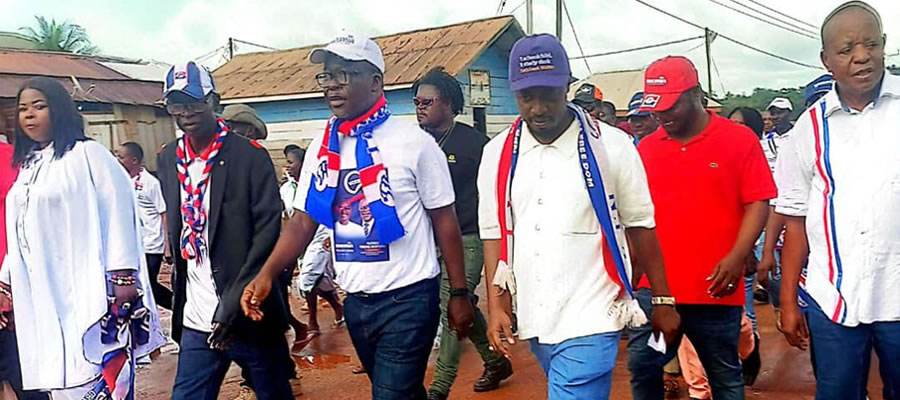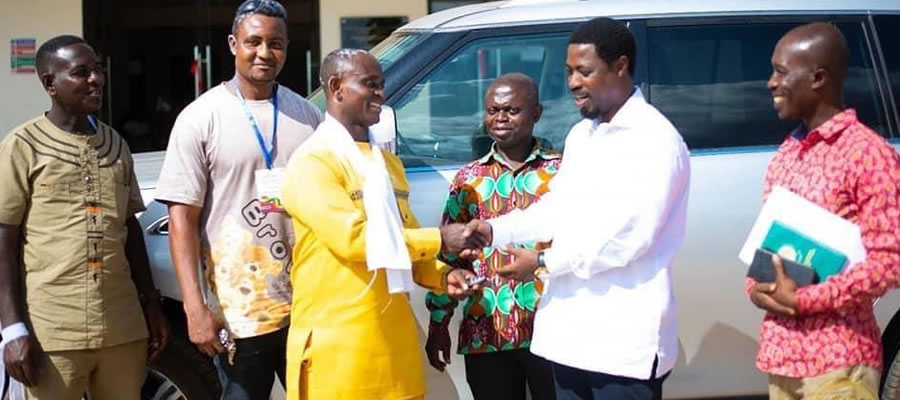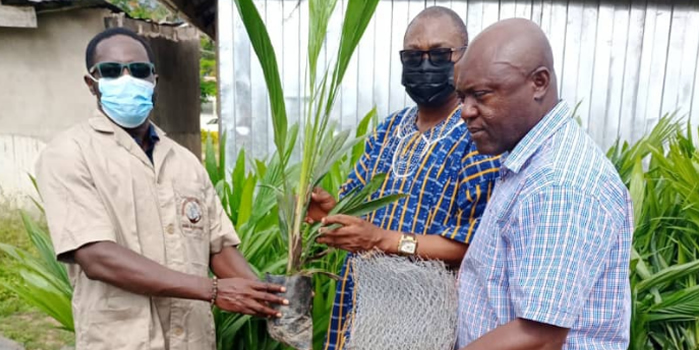

Physical and Natural Environment
The physical and the natural environment are essential elements or factors for determining socio-economic development of the Municipality. This stems from the fact that apart from being potential resources, they also serve as framework within which all development activities take place. The major factors that need critical analysis and their implications for development in the Municipality under physical and natural environment include location and size, climate, vegetation, relief and drainage, soil, geology and minerals, deforestation, mining and quarrying, bushfires, soil erosion and natural disasters, etc. The interaction between the human and physical environment and its development implications with respect to the above major factors are clearly and briefly described below.
Location and Size
The Bibiani- Anhwiaso-Bekwai Municipal is one of the nine (9) Metropolitan, Municipal and District Assemblies in the Western North Region. The Municipality is located between latitude 6° N, 3° N and longitude 2° W, 3° W. The Municipality is bounded on the north by the Atwima Mponua District in the Ashanti Region, south by the Wassa Amenfi West District in the Western Region, west by the Sefwi Wiawso Municipal Assembly in the Western North Region and east by the Upper Denkyira West District and Amansie West District in the Central Region and Ashanti region respectively.
The Municipality covers a total land area of 873 km square and had a population of 123,272 in 2010 and with a growth rate of 1.8% per annum, the projected population for 2018 is 142,365.
There are at least 345 communities with about 65 having a population above 500 persons (2010 Population and Housing Census) making the Municipality predominately rural. The exact location of the Municipality with respect to the regional and national context is indicated in Figures 1.2 and 1. 3. The Municipality capital, Bibiani is located 356 km to the northwest of Sekondi-Takoradi (the Regional Capital) and 88km to Kumasi, the nearest commercial centre.
The Municipality’s proximity to large commercial centre such as Kumasi coupled with good highway, makes it attractive in doing business in the Municipality. As a result, the Municipality experience a very good market day for food stuff especially among subsistence farmers who dominate the Municipality’s population.
Free flow of information from the regional and national level is hampered by the long distances between the Municipality capital and its regional and national capitals. Apparently, this situation results in high administrative cost for the Municipal Assembly and other organization and agencies operating in the Municipality. Prospective investors who want to invest in the Municipality are somehow reluctant due to the above-mentioned bottlenecks.
Climate
The Municipality is located in the equatorial climate with the annual rainfall average between 1200mm and 1500mm.The pattern is bimodal, falling between March - August and September- October. The dry season is noticeable between November - January. The peak periods for rainfall in the Municipality are June and October. The average temperature throughout the year is about 26°c.There is a high relative humidity averaging between 75% in the afternoon and 95% in the night and early morning.
The implication of the climate of the Municipality is that it is suitable for the growing of various crops particularly both cash and food crops. This is the reason why the Municipality is one of the leading producers of the cash crop like cocoa in Ghana.
The good climatic condition provides suitable water table which is good in potable water (boreholes and hand-dug wells) provision in the Municipality. However, the recently changed in the climatic conditions of the Municipality from previously short dry season (harmattan) to almost long dry season has damaging effects on the environment and farm outputs.
The heavy and prolonged rains associated with this type of climate adversely affect cocoa harvest (drying of cocoa beans), and aggravates the black pod disease that attacks cocoa. In addition, almost all the untarred roads in the Municipality become unmotorable during the rainy season.
Vegetation
The Municipality’s vegetation is of the moist semi-deciduous (equatorial rain forest) type. The BAB Municipal has a forest district which has a gross area of 961.52 sq.km of which 365.30sq.km constitutes Forest Reserves. The forest vegetation is made up of many different tree species including wawa (Triplochiton selerexylon), mahogany (Khaya invorensis), esa (Celtis), ofram (Terminalia superba), edinam (Entandro phragma ivorensio), onyina (Ceiba petandra), kyenkyen (Antiaris Africana) and odum (Milicia exelsa), Sapele etc. Hence, the Municipality is a suitable location for the establishment of timber firms. There are eight forest reserves under the Municipality out of which 7 are located within the boundaries of the Municipality. The seven forest reserves have a total area of abou t 286.17 sq.km as indicated in Table 1.8. The forest reserves serve as tourist attractions and influence the rainfall pattern in the Municipality.
The eight forest reserves are productive reserves where timber harvesting is done. Occasional bushfires, overexploitation and encroachment of land are threatening the existence of the reserves. The type of climate has positive impact on the heavy rainfall experiences in the Municipality. However, mechanized farming cannot be practised extensively in the Municipality due to the dense forest cover.
Relief and Drainage
The Municipality forms part of the country’s dissected plateau. The lowest and the highest points in the Municipality are 350m and 660m above sea levels respectively. This highest point is also the highest in the Western North Region at Attanyamekrom (Adiembra), near Sefwi Bekwai. A gently rolling landscape is found over lower Birimian rocks. Over the Tarkwaian rocks, the topography is rugged and hilly rather than smooth and flat or gently undulating.
The Municipality is endowed with a number of rivers and streams, the most important of which is the Ankobra River. The streams and rivers exhibit a dendritic pattern, which forms the Ankobra basin. Other forming tributaries are Awa, Krodua, Atronsu, Subriso, Kroseini, Suraw, Chira and Akataso. The relief and drainage systems favour the development of fish farming, and cultivation of valley bottom rice, sugarcane and dry season vegetables. The rivers can also be taped as resources for future establishment of irrigation schemes and production of potable water for the people in the Municipality. Due to the relatively low level of relief in the Municipality, road construction is less difficult and expensive. However, the presence of many rivers and streams in the Municipality also makes road construction at times very difficult and expensive. Figure 1.3 indicates the drainage system or map of the Municipality.
Figure 1.4: Drainage Map
Source: BABDA, 2017
Geology and Minerals
The geology for the Municipality is dominated by the Precambrian Metamorphic rocks of the Birrimian and Tarkwain formation which contains the mineral bearing rocks. There are also granite rocks and deposit of minerals such as gold and bauxite. The Oxysols soils are rich in mineral deposits making mining the most important and lucrative economic activity in the Municipality. The companies dealing in mining include; Mensin Gold Limited at Bibiani; Chirano Gold Limited at Chirano and Bossai Minerals Limited at Awaso. The presence of mineral deposits in the Municipality has the potential to generate royalties as revenue to the Municipal Assembly for development as well as create employment for the inhabitants. It also implies that there is going to be influx of people to the Municipality by the operations of the mining and social implications.
Soil
The Municipality is endowed with rich forest ochrosols and oxysols which support the cultivation of a wide variety of crops including cocoa, coffee, oil palm, plantain, cocoyam and cassava, etc. and other vegetables. It also makes the Municipality to have a comparative advantage in agriculture and agro-processing. Figure 4 indicates the soil types in the Municipality.
Biodiversity, Climate Change, Green Economy and Environment
The development activities of the Municipality which aim at achieving the Municipality objectives e.g. increasing crop production and increasing farmers’ incomes have consequences on the nature, stability and resilience of the environment upon which the long term sustainability of the Municipality‘s activities depend. It is therefore important to indicate the extent to which the biodiversity, climate change, green economy and environment provide opportunities and challenges including their impacts on the Municipality’s development
Most of the population’s livelihoods depend of the Municipality’s natural resource base. Unfortunately, environmental and natural resource/capital depletion has the potentials of posing as a major obstacle to fulfilling the growth potentials of the Municipality. Food supply, and dependence on natural resources, biodiversity loss, disease burden level, water and energy resources and increasing environmental degradation call for the Municipality to encourage green initiatives and climate change adaptability and mitigation measures in all its development processes including but not limited to biofuels, solar dryer, integrated water resources management, responsible consumption, agroforestry, conservation agriculture, organic agriculture, climate smart agriculture, green building, passive design, building energy efficiency, clean fuel, etc, etc.
However, the following are some of the key factors which affect the general environment negatively in the Municipality:
a. Deforestation
The Bibiani-Anhwiaso-Bekwai Municipal has large tracts of forest and economic trees. However, the high exploitation of timber for logs and lumber by both registered timber firms and illegal chainsaw operators has contributed significantly to deforestation in the Municipality. Unchecked farming practices including cocoa farming has also compounded the situation through encroachment on the virgin forest and forest reserves.
The development of settlements within and around the forest such as Aboduabo and others which depend on the forest for their livelihoods also impacts negatively on the forest. The heavily dependent of the people on firewood and charcoal for energy has seriously affected both secondary and virgin forests in the Municipality. For instance a total of 252.52 Ha of depleted land or forest was recorded during the last plan period. This situation has serious implications such as threat to livelihood, soil degradation, forest depletion, adverse climatic conditions and endangered species in the Municipality.
b. Quarrying
However, sand winning is done haphazardly in the Municipality, which destroys the environment and the vegetative cover. This poses a threat to animal, plant and human life.
c. Bushfires and Soil Erosion
The traditional method of farming, which involves the slash and burn, coupled with indiscriminate burning of the bush by unscrupulous people during the short dry season (harmattan) is practised in the Municipality. This action or activity leads to the depletion of the soil nutrients and low agricultural production among farmers in the Municipality.
Furthermore, the destructive nature of bushfires results in loss of farms and forest, thereby leading to loss of income and properties to individual farmers and the Municipality as a whole. The rainfall pattern in the Municipality has resulted in erosion in some of the communities; examples include Awaso, Ankra Muano, Asempaneye, and Aboduabo. The depletion of the forest stock because of excessive lumbering, destructive agricultural practices, mining and bush burning have all led to the deterioration of the land exposing the bare land surface leading to erosion. The implication is that there should proper drainage systems in these communities to prevent the erosion from further destroying the buildings and create big gullies.
Conditions of the Built Environment
The built environment (settlements) in the Municipality lacks development control or settlement plans apart from Bibiani, the Municipality capital. Settlements are built haphazardly with poor quality building materials, which have resulted in poor housing quality and its effect on the green economy. Most houses have structural defects: extinctive cracks, appear dilapidated, weak foundations, and ripped off or leaking roofs. Only a small proportion of the houses in the Municipality can be considered to be in good shape and contain basic facilities especially the few major towns such as Bibiani, Anhwiaso, Bekwai, Chirano, etc, . Generally, the housing situation in the district is not a problem of quantity but quality. Haphazard built environment constrains easy physical accessibility to individual houses and creates poor ventilation and inefficient use of building energy. The dilapidated and poor structures also serve as death traps and a health hazard to the inhabitants which has serious implication on the already small incomes of the people and the government.
Air pollution is also one of the environmental problems cause by the use of energy sources in the Municipality which comes from the mining activities and fuse from vehicles.
Aesthetic Features The Bibiani-Anhwiaso-Bekwai Municipal is not very much endowed with aesthetic features. Nonetheless, it has abundant virgin forest, flora and fauna as well as other tourist attractions such as the rich Alue Festival celebrated by the chiefs and people every year. The other equally important features or sites which are pleasing to the eyes or to watch are Mountains Scenry at Sefwi Bekwai, Mud Fish Pond at Sefwi Bekwai, Conveyer Belt at Awaso Bauxite Company, Mining Sites at Bibiani, Chirano and Awaso, Manmade Lake at Bibiani, Ankobra River(Salt) and the various hotels in the Municipality. They serve as potentials for the development of the tourism industry in the Municipality.
Land Management (Land Tenure System)
Land as part of the environment is managed mainly in the Municipality by the traditional rulers, family heads and other landowners. Farmers and prospective land developers purchase or secure land from the traditional leaders. The land is mainly used for the cultivation of both cash and food crops such as cocoa, coffee, palm nut, maize, cassava, plantain, cocoyam, yam and vegetables, etc. Part of the land is also used as forest reserves controlled by central government and settlement development. The abunu and abusa land tenancy are widely used in the Municipality for the cultivation of food and cash crops. Occasionally, there are incidence of fraud and improper transfer of land, which eventually lead to litigations. The various land uses in the Municipality is indicated in the land use map (Figure 1.5) of the Municipality. The almost non-existence of problems associated with land uses in the Municipality is a potential source of attracting prospective investors in the Municipality.
Figure 1. 5: Land Cover/Use Map
Water Security
Access to potable water of the people in the Municipality is not much of a problem. The Municipality is endowed with a number of rivers and streams, the most important of which is the Ankobra River. The topography is also rich with good water table conducive for taping underground water for domestic and industrial uses. The good rainfall can also harness for rain harvesting for commercial and domestic uses. According to the 2010 PHC, the distribution of households according to main source of water for drinking are Borehole/Pump/Tube well, pipe-borne water and Public tap/Standpipe. A percentage of 7.2 also rely on River/Stream as a source of water for drinking. Most rural households (39.9%) depend on Borehole/Pump/Tube well for drinking as against 12.8 per cent in the urban areas. However just a little above 3% in the rural areas have Pipe-borne inside their dwellings as a source of water for drinking. As a result, the DA within the next plan period should make adequate provision to potable water facilities and rehabilitate the existing ones to meet the growing demand for potable water to improve the health and development of the people.
Natural and Man-made Disasters With the exception of torrential rainfalls, pest insect infestation such as armyworm and anthrax and occasional bush and domestic fires which sometimes cause extensive destruction to forest reserves, crops and properties, the Municipality is not seriously prone to natural disasters. This could serve as an incentive to attract potential investors to the Municipality and reduce the burden of the Assembly in solving disaster related issues in the Municipality.
Natural Resources Utilisation
The water resources in the Municipality are being threatened especially the main river Ankobra by the activities of illegal mining and bad farming practices. The legal and big mining companies operating in the Municipality mainly operate within the mining and environmental laws of the country with limited negative impacts of the general environment.
The Municipality has large tracts of forest and economic trees. However, the high levels of exploitation of timber for logs and lumber by both registered timber firms and illegal chainsaw operators has contributed significantly to deforestation in the Municipality. Unchecked farming practices including cocoa farming has also compounded the situation through encroachment on the virgin forest and forest reserves. The development of some settlements within and around the forest which depend on the forest for their livelihoods also impacts negatively on the forest. The heavily dependent of the people on firewood and charcoal for energy has seriously affected both secondary and virgin forests in the Municipality. This situation has serious implications such as threat to livelihood, soil degradation, forest depletion, adverse climatic conditions and endangered species in the Municipality. Sand winning is done haphazardly in the Municipality, which destroys the environment and the vegetative cover. This poses a threat to animal, plant and human life.
Date Created : 5/3/2023 12:00:00 AM













 facebook
facebook
 twitter
twitter
 Youtube
Youtube
 +233 593 831 280
+233 593 831 280 0800 430 430
0800 430 430 GPS: GE-231-4383
GPS: GE-231-4383 info@ghanadistricts.com
info@ghanadistricts.com Box GP1044, Accra, Ghana
Box GP1044, Accra, Ghana